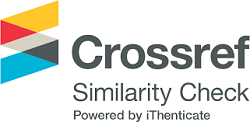Exellent Color Quality and Luminous Flux of WLEDs Using Triple-Layer Remote Phosphor Configuration
Abstract
This study proposed a triple-layer remote phosphor (TRP) structure to improve the color and luminous flux of white LEDs (WLEDs). TRP structure consists of 3 different phosphor layers: yellow YAG:Ce3+ layer below, red CaMgSi2O6:Eu2+,Mn2+ phosphor on top and green layer Ba2Li2Si2O7:Sn2+,Mn2+ phosphor in the middle. Using red CaMgSi2O6:Eu2+,Mn2+ to control the red light component leads to increased color rendering index (CRI). Utilize the green CaMgSi2O6:Eu2+,Mn2+ phosphor to control the green light component results in the increase in luminous efficacy (LE) of WLEDs. Furthermore, when the concentration of these two phosphors increased, yellow layer concentration YAG:Ce3+ decreased to maintain average correlated color temperatures (ACCTs) in the range from 6000 K-8500K. Besides CRI and LE, color quality scale (CQS) is also analyzed through concentration control of green phosphor and red phosphor. The research results show that the higher the concentration of CaMgSi2O6:Eu2+,Mn2+, the better for CRI. In contrast, CRI decreased significantly when increasing the concentration of Ba2Li2Si2O7:Sn2+,Mn2+. Meanwhile, CQS achieve notable enhancement in the concentration range of 10% -14% CaMgSi2O6:Eu2+,Mn2+, regardless of Ba2Li2Si2O7:Sn2+,Mn2+ concentration. LE, in particular, can also increase by more than 40% along with the improvement of CRI and CQS with the reduction of the backscattered light and addition of green light. Research results are a valuable reference for producers who wish to improve the color quality and enhance the luminous flux of WLEDs.

This is an Open Access article distributed under the terms of the Creative Commons Attribution License (http://creativecommons.org/licenses/by/4.0/), which permits unrestricted use, distribution, and reproduction in any medium provided the original work is properly cited.
Keywords
Full Text:
PDFTime cited: 0
DOI: http://dx.doi.org/10.25073/jaec.202041.255
Refbacks
- There are currently no refbacks.
Copyright (c) 2020 Journal of Advanced Engineering and Computation

This work is licensed under a Creative Commons Attribution 4.0 International License.









